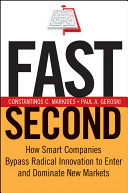Who beat Amazon?
Which company created on-line bookselling in the 1990s? Amazon.com? Nope. The first on-line bookstore was set up by an Ohio-based bookseller named Charles Stack in 1991. Jeff Bezos didn’t launch Amazon till four years later.
We’re constantly being told that leaders need to foster a culture of innovation, to move into Blue Ocean spaces where no competitors exist, then profit from the customers before our competitors copy us and move into the space we have created.
Henry Ford said ‘come second to market’
Well, not always. Henry Ford used to argue that it made more sense to be second to market – let someone else take the risks of seeing if something new is what customers will buy. Then, when the market is proven, often at great expense, follow in and do it better. That’s the core argument in this book, and the authors lines up plenty of examples to prove their point.
And they do have one. The argument against them is the first mover advantage argument – That markets move so fast nowadays you need to be first to market with something new so you can mop up the customers. That may be true if there’s only room for one dominant supplier, and if your aim is to be that dominant supplier – the Amazon of your marketplace, if you will. But there’s usually plenty of room for smaller niche players who take the main innovation, tweak it a bit and find a space in the market that way. It’s like ‘the long tail’ argument.
But, do markets move too fast today for ‘be second to market’ to work?
Tom Peters argues that markets move so fast that trying to be second to market means you will just be mopping up the leftovers as those who were brave enough to lead and create a new market take all the prizes. Well, sometimes, maybe. But, not always.
The uncomfortable answer is that sometimes being first to market is the winning strategy and sometimes being second or even third, when the pioneers have proved what works and what doesn’t and lost all their money in the process, is the right strategy.
It seems odd to say ‘Take the lead on being second or third’ but leadership doesn’t always mean being first to market. That’s my view, anyway (in synch with the authors of this book).
Balancing the risk: Being closer to customers increases the chances of success
Nobody can tell you which one works in your particular situation (a strategy of being first, second or third to market). But, the closer you are to knowing your customers’ or potential customers’ needs – to instinctively know what they want even before they know it themselves – the more likely your innovation is to be a winner.
And that, though it doesn’t explicitly say so in this book, is why leaders need to be as ‘close to the customer’ (thank you Tom Peters, even if it was 25 years ago he said it) as possible. That means interacting with customers whenever you can, not receiving reports from middle managers about the customer base, but immersing yourself in the customer base, no matter how lofty your role in the organization is.
End of preachy bit. Anyway, interesting book…
Little bit more about it here: Fast Second on Wikipedia










Leave a Reply